Are you curious about whether almonds are considered a fruit? Well, the answer might surprise you! Almonds are indeed classified as a fruit, but they’re not your typical juicy and sweet kind. In fact, almonds belong to the stone fruit family, just like peaches and cherries.
They may not be as vibrant or succulent as other fruits, but they have their own unique qualities that make them truly special. The almond tree produces fruits called drupes, which have a hard outer shell surrounding a single seed – the almond itself. This makes it different from traditional fruits with fleshy pulp.
While these drupes might not be what you envision when thinking of fruit, they still provide numerous culinary and nutritional benefits. So why is this distinction important? Understanding that almonds are technically fruits can help expand your culinary horizons and open up new possibilities in the kitchen.
Whether you enjoy them raw or roasted, whole or sliced, almonds offer endless opportunities to add flavor and texture to your favorite dishes. In this article, we’ll delve into the botanical classification of almonds, explore their anatomy as a fruit, discuss how almond trees reproduce, differentiate between nuts and fruits, and highlight the various culinary and nutritional uses of this versatile ingredient.
So get ready to embrace freedom in your understanding of almonds as a fascinating fruit!

Contents
The Botanical Classification of Almonds
Did you know that almonds are actually classified as seeds, not fruit? It may come as a surprise, but it’s true! When we think of almonds, we often associate them with fruits like cherries or peaches. However, botanically speaking, almonds belong to the category of seeds.
This is because they develop from the ovary wall of the almond tree and contain a single seed within their hard shell.
Almond cultivation techniques have been perfected over centuries, allowing farmers to produce high-quality almonds in abundance. From proper pruning and irrigation methods to pest control strategies, these techniques ensure that almond trees thrive and bear healthy fruits.
In addition to being delicious and nutritious snacks, almonds can also cause allergies or intolerances in some individuals. If you experience symptoms such as itching or swelling after consuming almonds or almond products, it’s important to consult with a healthcare professional for proper diagnosis and guidance.
So now you know – almonds may look like fruits, but they are indeed seeds! Enjoy their versatility in cooking and baking while being mindful of any potential allergic reactions.
The Anatomy of Almonds as a Fruit
When you bite into a delicious almond, you might not realize that what you’re actually enjoying is the inner seed of a flowering plant. Almonds are the fruit of the almond tree, which belongs to the Rosaceae family.
These trees go through a fascinating growth process, starting with small pink flowers that bloom in early spring. In order for almonds to form, these flowers need to be pollinated by bees or other insects. The pollination process is crucial for the development of almonds as it allows fertilization to occur and leads to the formation of the almond fruit.
Once pollinated, the almond fruit begins to grow and mature over several months until it reaches its full size and ripens on the tree. So next time you savor an almond’s creamy texture and nutty flavor, remember that it all began with an almond tree’s growth and intricate pollination process.
The Reproduction Process of the Almond Tree
As you savor the creamy texture and nutty flavor of an almond, take a moment to appreciate the fascinating reproduction process of the almond tree.
The reproductive cycle of an almond tree begins with its beautiful blossoms that attract bees and other insects. These insects play a crucial role in the pollination process by transferring pollen from the male parts of one blossom to the female parts of another.
Once pollinated, the ovaries within the flowers develop into fruits that eventually harden and form what we know as almonds. It’s incredible how nature’s intricate dance ensures that each tiny almond is created through this delicate process.
So next time you enjoy an almond, remember to thank those busy bees for their important part in bringing these delicious fruits to your plate!
Nut vs. Fruit: Understanding the Difference
Take a moment to understand the distinction between nuts and fruits, as you bite into the crunchy texture of a delectable almond. While almonds are commonly referred to as nuts, they’re actually seeds that come from the fruit of the almond tree.
Fruits are derived from flowering plants and contain seeds, like almonds. On the other hand, vegetables are typically derived from other parts of the plant, such as leaves or stems.
Almonds offer numerous health benefits, including being a rich source of healthy fats, protein, fiber, and vitamins. They can help lower cholesterol levels, reduce blood sugar spikes, and promote weight loss.
So next time you enjoy an almond snack or sprinkle some crushed almonds on your salad or oatmeal, remember that you’re indulging in a nutritious fruit rather than a nut!
Culinary and Nutritional Uses of Almonds
Almonds are versatile ingredients that can be used in a variety of culinary dishes and offer numerous nutritional benefits. Whether you’re a health-conscious foodie or just looking to experiment in the kitchen, almonds have got you covered.
From savory to sweet, these little powerhouses can be incorporated into almost any recipe. Crushed almonds make a perfect crust for chicken or fish, adding a delightful crunch and nutty flavor. You can also use almond flour as a gluten-free alternative in baking, making delicious cookies or muffins.
Not only do almonds taste great, but they’re also packed with health benefits. They’re high in healthy fats, protein, fiber, vitamins, and minerals like magnesium and vitamin E. Incorporating almonds into your diet can help support heart health and improve brain function while keeping you satiated and energized throughout the day.
So go ahead and get creative with almonds – your taste buds and body will thank you!
Conclusion
In conclusion, almonds are indeed classified as fruits. They possess all the characteristics of a fruit, including their development from flowering plants and their ability to encase a seed within a protective outer layer.
Almonds also play an important role in culinary and nutritional applications, being a versatile ingredient in various dishes and providing numerous health benefits.
So next time you enjoy some almonds, remember that you’re indulging in a delicious and nutritious fruit!

